-
Countries
-
Data and Analysis
-
Special Focus
-
Crisis Responses

Contact
dtmpakistan@iom.int
Language
English
Location
Pakistan
Period Covered
Aug 01 2023
Aug 31 2023
Activity
- Survey
- Mobility Tracking
- Site Assessment
From June to October 2022, storms and heavy monsoon rains in Pakistan caused widespread flooding and landslides across the country. As of 18 November 2022, according to the National Disaster Management Authority (NDMA), up to 33 million people have been affected by the floods and a total of 90 districts have been labelled by the Government of Pakistan as ‘calamity-hit’.
In August 2023, IOM implemented a fourth round of the CNI to provide partners with timely information on the displacement situation, multisectoral needs of the affected population as well as the recovery needs at the settlement level.6 For this round, IOM implemented the CNI in 10 districts of Khyber Pakhtunkhwa. The CNI was conducted in 3,107 flood-affected settlements or settlements that hosted temporary displaced persons (TDPs) across the 10 targeted districts.7
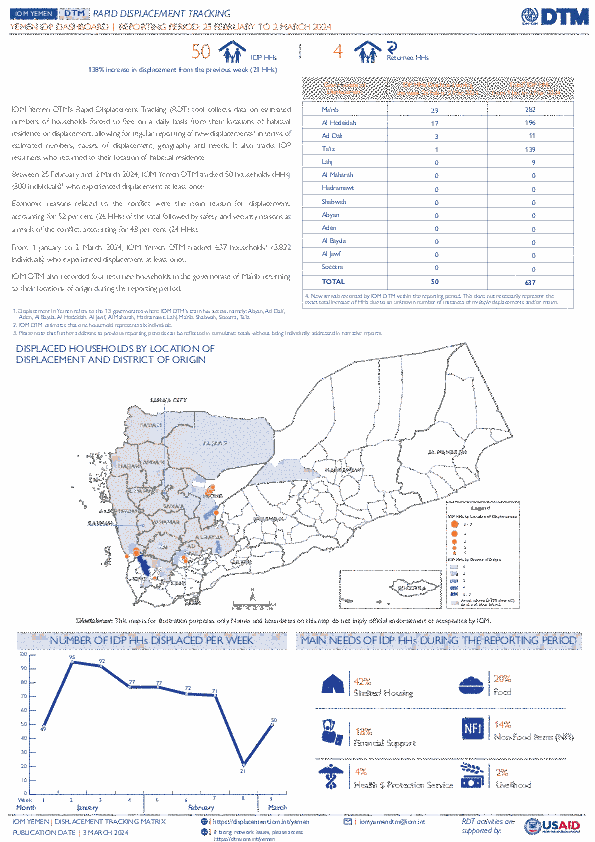
Contact
DTM Yemen, iomyemendtm@iom.int
Language
English
Location
Yemen
Period Covered
Feb 25 2024
Mar 02 2024
Activity
- Mobility Tracking
- Event Tracking
IOM Yemen DTM’s Rapid Displacement Tracking (RDT) tool collects data on estimated numbers of households forced to flee on a daily basis from their locations of origin or displacement, allowing for regular reporting of new displacements in terms of estimated numbers, geography, and needs. It also tracks returnees who returned to their location of origin.
From 1 January to 2 March 2024, IOM Yemen DTM tracked 637 households (HH) (3,822 Individuals) who experienced displacement at least once.
Between 25 February and 2 March 2024, IOM Yemen DTM tracked 50 households (300 individuals) displaced at least once. The majority of people moved into/within the following governorates and districts:
- Ma’rib (29 HHs) – Ma’rib City (19 HHs), Ma’rib (7 HHs), Harib (3 HHs) districts. Most displacements in the governorate originated from Ma’rib and Sanaa.
- Al Hodeidah (17 HHs) – Hays (15 HHs), Al Khukhah (2 HHs) districts. Most displacements in the governorate originated from Al Hodeidah and Ta’iz.
- Ad Dali (3 HHs) – Ad Dali (3 HHs) district. All displacements in the governorate were internal.
The majority of people moved from the following governorates and districts:
- Al Hodeidah (13 HHs) – Hays (7 HHs), Al Jarrahi (2 HHs), Al Mina (1 HH) districts.
- Ta’iz (9 HHs) – Maqbanah (6 HHs), At Taiziyah (1 HH), Al Waziyah (1 HH) districts.
- Ma’rib (7 HHs) – Harib (3 HHs), Raghwan (2 HHs), Al Jubah (1 HH) districts.
IOM identified 35 households displaced in the previous reporting period, which covered 18 - 24 February 2024, in the governorates of Al Hodeidah (26 HHs), Ma’rib (8 HHs), Ta’iz (1 HH). These figures have been added to the cumulative displacement total recorded since the beginning of the year.
Contact
DTM Yemen, iomyemendtm@iom.int
Location
Yemen
Activity
- Mobility Tracking
- Event Tracking
Period Covered
Feb 25 2024 -Mar 02 2024
From 1 January to 2 March 2024, IOM Yemen DTM tracked 637 households (HH) (3,822 Individuals) who experienced displacement at least once.
Between 25 February and 2 March 2024, IOM Yemen DTM tracked 50 households (300 individuals) displaced at least once. The majority of people moved into/within the following governorates and districts:
- Ma’rib (29 HHs) – Ma’rib City (19 HHs), Ma’rib (7 HHs), Harib (3 HHs) districts. Most displacements in the governorate originated from Ma’rib and Sanaa.
- Al Hodeidah (17 HHs) – Hays (15 HHs), Al Khukhah (2 HHs) districts. Most displacements in the governorate originated from Al Hodeidah and Ta’iz.
- Ad Dali (3 HHs) – Ad Dali (3 HHs) district. All displacements in the governorate were internal.
The majority of people moved from the following governorates and districts:
- Al Hodeidah (13 HHs) – Hays (7 HHs), Al Jarrahi (2 HHs), Al Mina (1 HH) districts.
- Ta’iz (9 HHs) – Maqbanah (6 HHs), At Taiziyah (1 HH), Al Waziyah (1 HH) districts.
- Ma’rib (7 HHs) – Harib (3 HHs), Raghwan (2 HHs), Al Jubah (1 HH) districts.
Population Groups
Survey Methodology
Unit of Analysis Or Observation
Type of Survey or Assessment
Keywords
Geographical Scope
Administrative boundaries with available data
The current dataset covers the following administrative boundaries
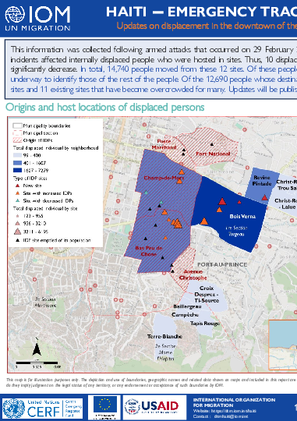
Contact
dtmhaiti@iom.int
Language
English
Location
Haiti
Period Covered
Feb 29 2024
Mar 02 2024
Activity
- Mobility Tracking
- Event Tracking
This information was collected following armed attacks that occurred on 29 February 2024 in the downtown of the municipality of Port-au-Prince. Displacement following these incidents affected internally displaced people who were hosted in sites. Thus, 10 displacement sites were completely emptied of their populations and 2 others saw their numbers significantly decrease. In total, 14,740 people moved from these 12 sites. Of these people, DTM teams have already identified the destinations of 12,690 people and assessments are underway to identify those of the rest of the people. Of the 12,690 people whose destinations were identified, 13% took refuge with host families and 87% in 14 sites including 3 new sites and 11 existing sites that have become overcrowded for many.
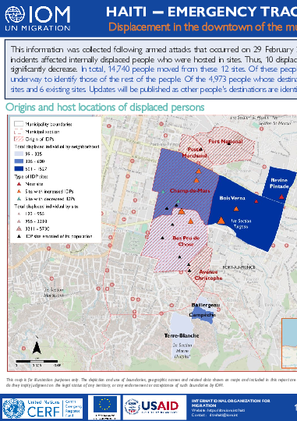
Contact
dtmhaiti@iom.int
Language
English
Location
Haiti
Period Covered
Feb 29 2024
Mar 01 2024
Activity
- Mobility Tracking
- Event Tracking
This information was collected following armed attacks that occurred on 29 February 2024 in the downtown of the municipality of Port-au-Prince. Displacement following these incidents affected internally displaced people who were hosted in sites. Thus, 10 displacement sites were completely emptied of their populations and 2 others saw their numbers significantly decrease. In total, 14,740 people moved from these 12 sites. Of these people, DTM teams have already identified the destinations of 4,973 people and assessments are underway to identify those of the rest of the people. Of the 4,973 people whose destinations were identified, 17% took refuge with host families and 83% in 8 sites including 2 new sites and 6 existing sites. Updates will be published as other people's destinations are identified

Contact
DTM DRC, iomdrcdtm@iom.int
Language
English
Location
Democratic Republic of the Congo
Period Covered
Feb 21 2024
Feb 28 2024
Activity
- Mobility Tracking
- Event Tracking
The conflict in the eastern region of the Democratic Republic of Congo (DRC), particularly in the province of North Kivu, has become increasingly complex over the years. Various armed groups, including the M23 group and the Congolese armed forces (FARDC) and their allies, have been involved in the conflict, leading to widespread instability and unprecedented humanitarian crises. The fighting has led to a large-scale displacement and an increasing population in need of humanitarian assistance, access to which remains extremely difficult.
Regional initiatives to improve peace and security in the region have intensified in recent weeks. In addition to the deployment of the Southern African Development Community (SADC) forces last December, initiatives such as the Heads of State summit in Addis Ababa on 17 February 2024 and the Heads of State meeting in Angola on 27 February 2024 took place with the aim of relaunching the peace process, secure a ceasefire between the FARDC and the M23 group and initiate direct dialogue between the Democratic Republic of Congo and Rwanda.
The escalation of tensions in recent weeks has triggered a continued movement of populations from host communities and displaced persons previously living in sites or with host families on the Sake-Bweremana axis towards the province of South Kivu in Kalehe territory, to the direction of Goma and the surrounding areas. However, since the last assessment (23 February), a slight upward trend in returns has been observed after the relative calm period between 21 and 28 February 2024.
Since the beginning of the crisis, IOM, through its Displacement Tracking Matrix (DTM), has continued conducting a series of rapid assessments, including emergency monitoring (EET/ERM), crisis analysis and registration with the aim of responding to immediate information needs in order to understand displacement dynamics.
This report presents the results of assessments carried out in the various displacement and return areas between 21 and 28 February 2024.
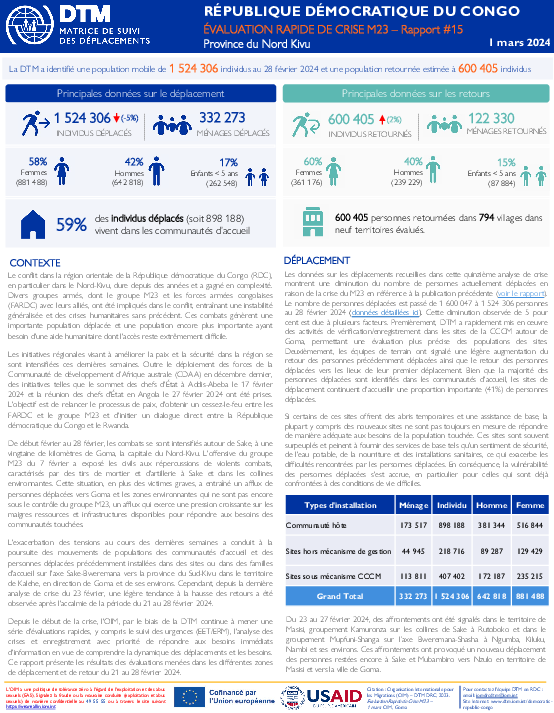
Contact
DTM DRC, iomdrcdtm@iom.int
Language
French
Location
Democratic Republic of the Congo
Period Covered
Feb 21 2024
Feb 28 2024
Activity
- Mobility Tracking
- Event Tracking
Le conflit dans la région orientale de la République démocratique du Congo (RDC), en particulier dans le Nord-Kivu, dure depuis des années et a gagné en complexité. Divers groupes armés, dont le groupe M23 et les forces armées congolaises (FARDC) avec leurs alliés, ont été impliqués dans le conflit, entraînant une instabilité généralisée et des crises humanitaires sans précédent. Ces combats génèrent une importante population déplacée et une population encore plus importante ayant besoin d'une aide humanitaire dont l'accès reste extrêmement difficile.
De début février au 28 février, les combats se sont intensifiés autour de Sake, à une vingtaine de kilomètres de Goma, la capitale du Nord-Kivu. L'offensive du groupe M23 du 7 février a exposé les civils aux répercussions de violents combats, caractérisés par des tirs de mortier et d'artillerie à Sake et dans les collines environnantes. Cette situation, en plus des victimes graves, a entraîné un afflux de personnes déplacées vers Goma et les zones environnantes qui ne sont pas encore sous le contrôle du groupe M23, un afflux qui exerce une pression croissante sur les maigres ressources et infrastructures disponibles pour répondre aux besoins des communautés touchées.
L'exacerbation des tensions au cours des dernières semaines a conduit à la poursuite des mouvements de populations des communautés d'accueil et des personnes déplacées précédemment installées dans des sites ou dans des familles d'accueil sur l'axe Sake-Bweremana vers la province du Sud-Kivu dans le territoire de Kalehe, en direction de Goma et de ses environs. Cependant, depuis la dernière analyse de crise du 23 février, une légère tendance à la hausse des retours a été observée après l'accalmie de la période du 21 au 28 février 2024.
Depuis le début de la crise, l'OIM, par le biais de la DTM continue à mener une série d'évaluations rapides, y compris le suivi des urgences (EET/ERM), l'analyse des crises et enregistrement avec priorité de répondre aux besoins immédiats d'information en vue de comprendre la dynamique des déplacements et les besoins. Ce rapport présente les résultats des évaluations menées dans les différentes zones de déplacement et de retour du 21 au 28 février 2024.
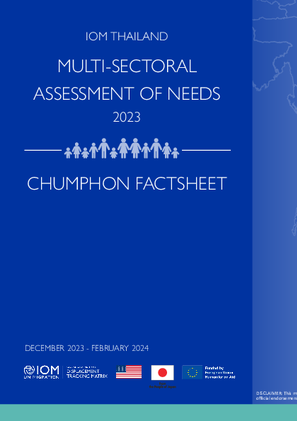
Contact
DTMThailand@iom.int
Language
English
Location
Thailand
Period Covered
Dec 14 2023
Feb 12 2024
Activity
- Survey
- Site Assessment
This factsheet aims to provide a snapshot of multi-sectoral conditions, needs, and challenges among Myanmar migrants in Chumphon province as captured between December 2023 and February 2024 by IOM Thailand’s multi-sectoral assessment of needs. The purpose of this assessment is to provide insights regarding the severity of needs among migrant populations, identify vulnerable population groups and geographic areas with the most acute needs, inform assistance planning and relevant Sustainable Development Goals (SDGs) targets, and provide sectoral and inter-sectoral baselines for future assessments.
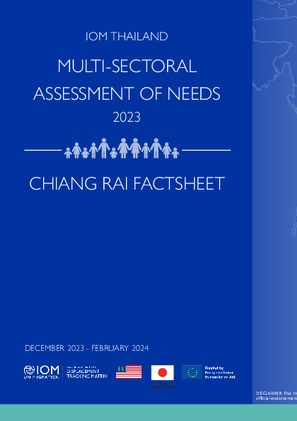
Contact
DTMThailand@iom.int
Language
English
Location
Thailand
Period Covered
Dec 20 2023
Feb 05 2024
Activity
- Survey
- Site Assessment
This factsheet aims to provide a snapshot of multi-sectoral conditions, needs, and challenges among Myanmar migrants in Chiang Rai province as captured between December 2023 and February 2024 by IOM Thailand’s multi-sectoral assessment of needs. The purpose of this assessment is to provide insights regarding the severity of needs among migrant populations, identify vulnerable population groups and geographic areas with the most acute needs, inform assistance planning and relevant Sustainable Development Goals (SDGs) targets, and provide sectoral and inter-sectoral baselines for future assessments.
Contact
DTMChad@iom.int
Location
Chad
Activity
- Mobility Tracking
- Site Assessment
- Village Assessment
Period Covered
Dec 22 2023 -Jan 24 2024
From December 22nd 2023 to January 24th 2024, the DTM Chad has conducted the round 22 of Sites and Villages assessment accross 305 locations.
During this round, a total of 261,672 displaced individuals were identified, including 219.393 internally displaced persons, 25,007 internal returnees and 17,272 returnees from abroad.
Population Groups
IDPs
Returnee (Previously Displaced Abroad)
Returnee (Previously Internally Displaced)
Survey Methodology
Unit of Analysis Or Observation
Admin Area 4
Site or Location
Type of Survey or Assessment
Key Informant
Keywords
Geographical Scope Partial Coverage
Administrative boundaries with available data
The current dataset covers the following administrative boundaries